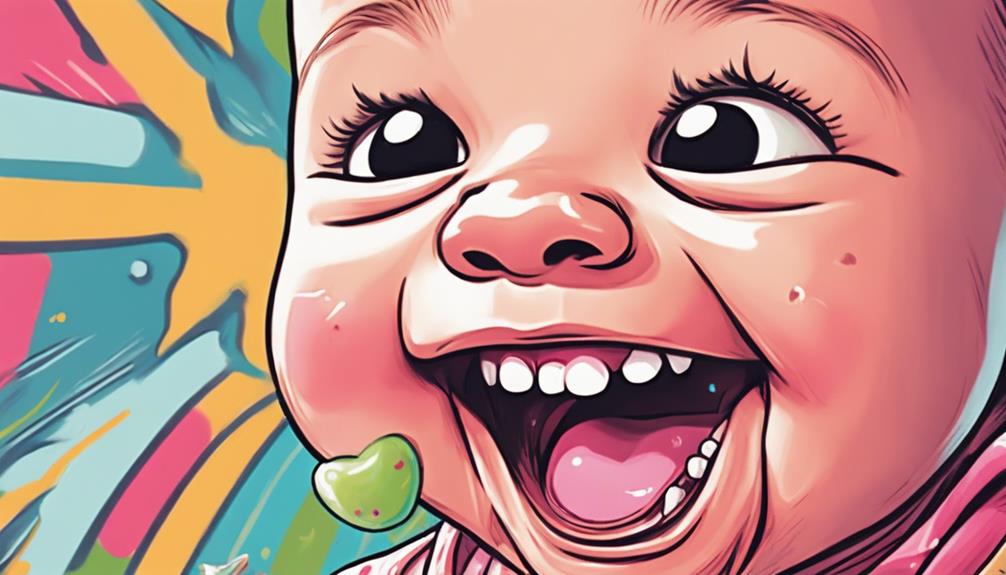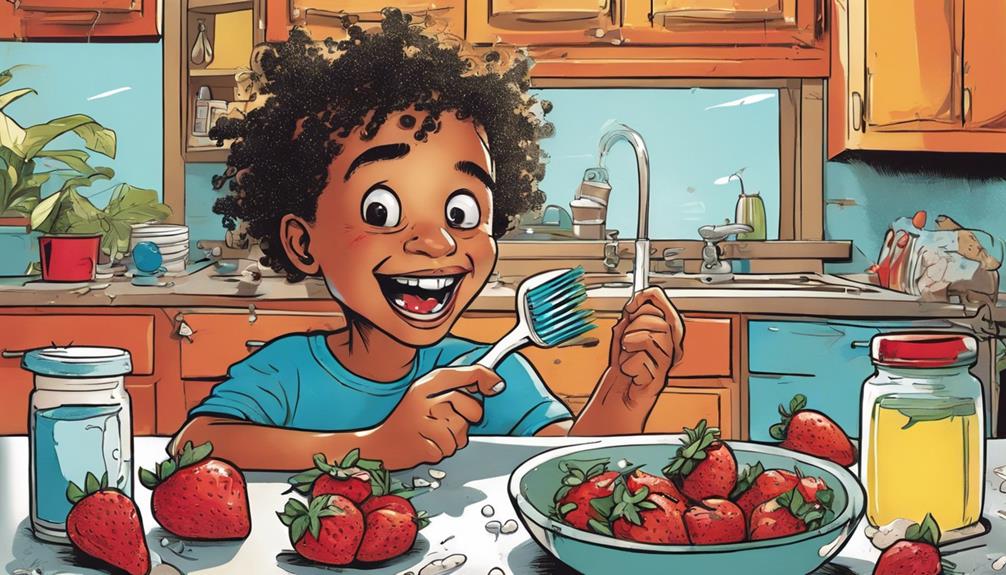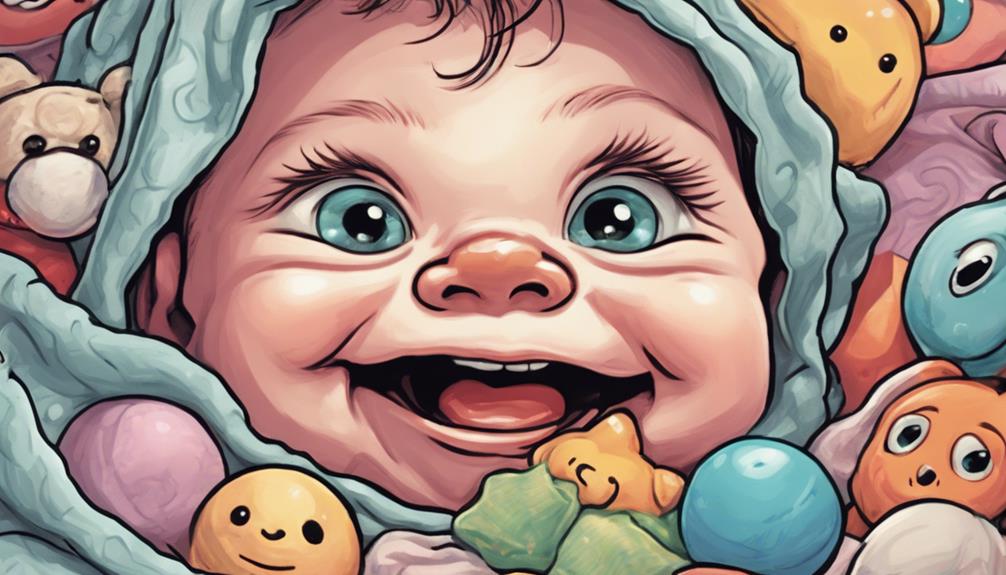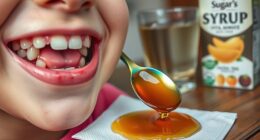Babies usually get their first teeth, the lower central incisors, around 5 to 7 months old. These tiny teeth are the first to emerge, making their entrance right in the front of your baby's mouth. After the lower incisors, the upper central incisors come in between 6 to 8 months. This tooth eruption follows a predictable order, gradually moving from the front teeth to the back. It's fascinating to observe this process as your baby grows. If you're curious about the teething timeline and other related information, there's plenty more to explore.
Key Takeaways
- The first teeth to emerge are typically the lower central incisors, usually appearing between 5 to 7 months of age.
- Following the lower central incisors, the upper central incisors usually erupt around 6 to 8 months.
- The order of eruption generally progresses from the front teeth to the back teeth.
- By age 3, most children have a complete set of 20 primary teeth.
Understanding Teething
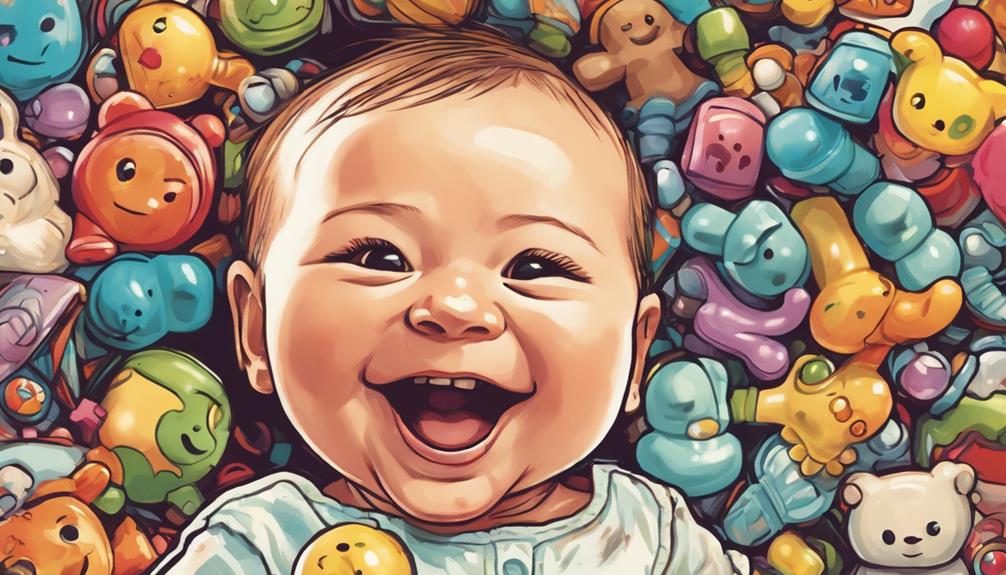
Teething can be an exciting and sometimes challenging milestone for you and your baby, as those little teeth start to make their appearance. Typically, you can expect your baby's first baby tooth to emerge between 4 to 7 months of age, with the lower central incisors being the first primary teeth to erupt. This process of tooth eruption can vary, with some infants getting their first tooth as early as 3 months or as late as 12 months.
As the teething process continues, you'll notice that the upper central incisors usually follow, appearing about 4 to 8 weeks after the lower ones. The order of tooth eruption generally progresses from the front to the back of your baby's mouth. After the lower and upper central incisors, the lateral incisors and molars will start to emerge.
Teething Timeline
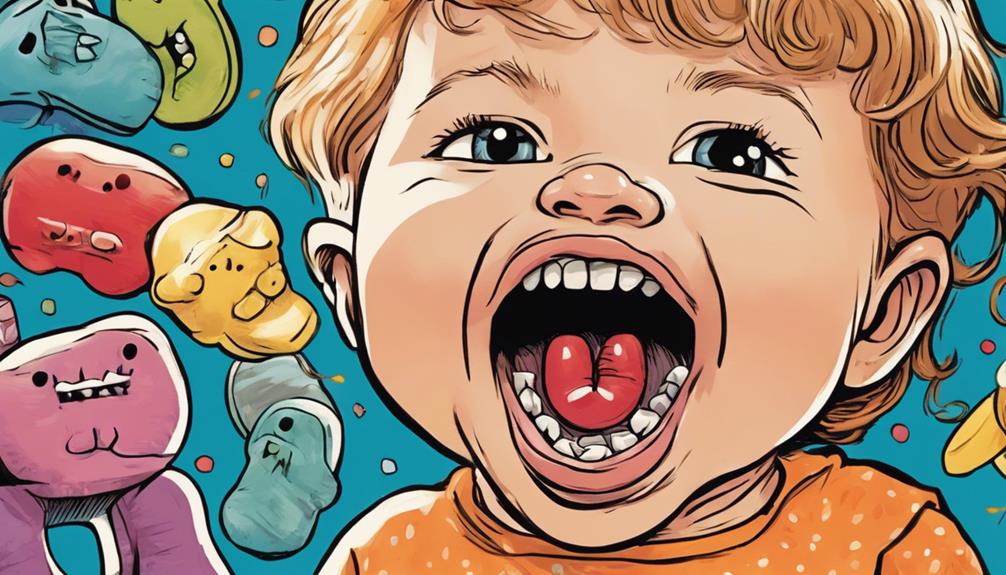
When it comes to teething, you'll notice a typical timeline that most babies follow.
Generally, infants start around 6 to 12 months, with the lower central incisors coming in first.
However, keep in mind that every baby is unique, and some may experience variations in their teething journey.
Typical Teething Age
Most babies start showing signs of teething around 6 months old, but it's common for some to begin as early as 3 months or as late as 12 months. This timeline can be a bit unpredictable, and you might find yourself managing the challenges that come with teething during these months.
The first teeth to appear are typically the lower central incisors, emerging between 5 to 7 months. Following those, the upper central incisors usually come in around 6 to 8 months. Understanding this timeline can help you prepare for the teething journey ahead.
Here's a quick overview of teething age:
| Tooth Type | Typical Age of Eruption |
|---|---|
| Lower Central Incisors | 5 to 7 months |
| Upper Central Incisors | 6 to 8 months |
| Lower Lateral Incisors | 10 to 12 months |
| Upper Lateral Incisors | 9 to 11 months |
As your baby grows, they'll gradually get their first set of teeth, making this a memorable phase in their development. Baby teeth development is an important milestone in your child’s growth, as it signals the start of their ability to chew solid foods and eventually speak clearly. It’s essential to take care of their baby teeth by teaching them good oral hygiene habits and scheduling regular visits to the dentist. This early attention to their dental health will set the stage for a lifetime of healthy teeth and gums.
Tooth Eruption Sequence
Understanding the typical teething age sets the stage for the tooth eruption sequence, helping you anticipate which teeth will come in next and when to expect them.
The first teeth to typically emerge in your baby are the bottom central incisors, usually appearing between 6 to 10 months.
Here's the general order baby teeth erupt:
- Lower Central Incisors: 6 to 10 months
- Upper Central Incisors: 8 to 12 months
- Upper Lateral Incisors: 9 to 13 months
After the lateral incisors, the canines usually show up between 16 to 22 months.
Finally, the second molars complete the set of 20 primary teeth, typically emerging between 25 to 33 months.
By around age 3, most babies will have all their teeth in place.
Knowing the order baby teeth come in can help you track your child's progress and prepare for the challenges of teething.
Keep this timeline in mind as your little one grows!
Individual Variability Factors
Teething timelines can vary considerably from baby to baby, so don't be alarmed if yours doesn't follow the typical pattern.
While most babies start teething between 6 to 9 months, some might begin as early as 3 months or as late as 12 months. This individual variability is completely normal. You might even notice your baby is teething before the 4-month mark or find that some are born with teeth already.
Generally, the first set of teeth to emerge are the lower central incisors, followed by the upper central incisors around 8 to 12 months. However, the order of tooth eruption can differ among children. By the time your little one reaches age 3, they should have all 20 primary teeth, although genetics and developmental factors can influence this timeline.
It's important to monitor your baby's growth patterns and keep an eye on their teething progress. If you have concerns about delayed teething or any unusual symptoms, don't hesitate to consult your pediatrician for guidance.
Signs of Teething
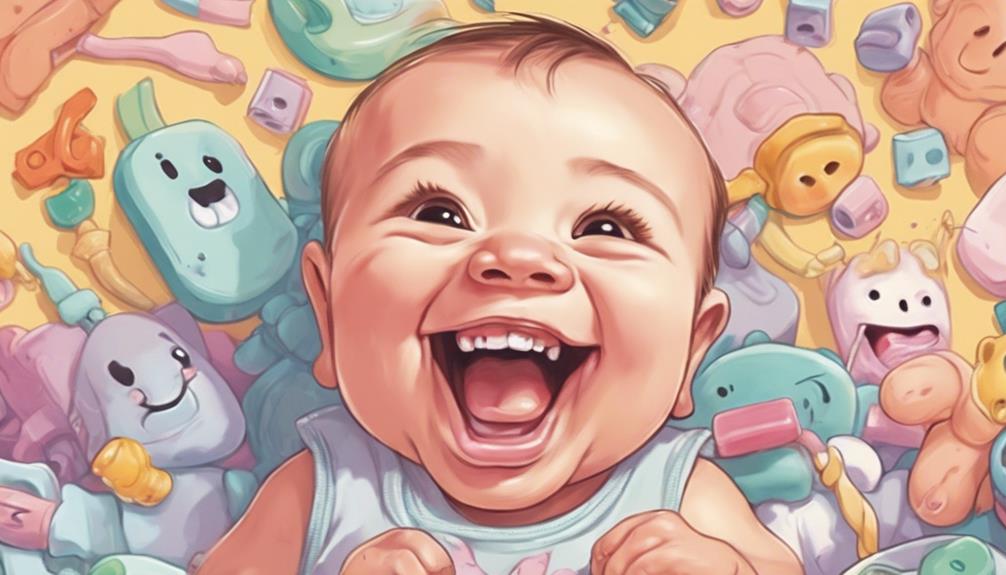
When your baby starts teething, you might notice a few key signs. Increased drooling, swollen gums, and a strong urge to chew on anything nearby are common symptoms.
It's crucial to pay attention to these changes, as they can help you understand your little one's discomfort.
Common Teething Symptoms
Babies often show a variety of signs that indicate they're starting to teeth, including increased drooling and a strong desire to chew on objects. As a parent, you might notice several common teething symptoms that signal your little one's discomfort.
Here are some typical signs of teething:
- Increased drooling: You may find your baby soaking through bibs or clothes.
- Sore gums: Touching their gums might reveal tenderness or swelling.
- Irritability or fussiness: Your baby could be more cranky than usual due to teething pain.
These signs of discomfort can be concerning, but remember that mild symptoms are part of the teething process.
While a slight temperature may occur, a true high fever isn't generally linked to teething.
It's essential to distinguish between normal teething symptoms and symptoms that may indicate other health issues, like diarrhea.
Keep an eye on your baby, and if you notice severe signs, consult your pediatrician for guidance.
Teething Timeline Overview
Most infants start showing signs of teething around 6 months, with the lower central incisors typically emerging first. This teething timeline can vary, as some babies may begin teething as early as 3 months or as late as 12 months. However, by the time they reach 3 years, most children will have all 20 primary teeth fully erupted.
As your baby approaches 6 months, keep an eye out for common signs of teething. Increased drooling is often one of the first indicators, along with irritability that may leave you wondering what's wrong. You might notice slight swelling of the gums, especially around where the lower central incisors are breaking through.
About 4 to 8 weeks after the lower central incisors emerge, the upper central incisors usually follow. This progression continues, leading to the appearance of additional teeth in the coming months.
Understanding this teething timeline can help you better support your little one through this natural, yet sometimes uncomfortable, phase of growth. Remember, each child is unique, so your baby's teething journey may differ.
Order of Tooth Emergence

The order of tooth emergence starts with the lower central incisors, which usually erupt between 6 to 10 months of age.
After those bottom front teeth, you can expect the upper central incisors to appear around 8 to 12 months.
As your baby continues to grow, the lateral incisors will typically emerge next, usually between 9 to 13 months.
Here's a quick overview of the order of tooth emergence:
- Lower Central Incisors: 6 to 10 months
- Upper Central Incisors: 8 to 12 months
- Lateral Incisors: 9 to 13 months
Following the first molars, the canines will make their appearance between 16 to 22 months.
Finally, the second molars come in last, typically between 25 to 33 months.
Understanding this order can help you keep track of your baby's dental development and prepare for the various stages of teething.
Knowing what to expect can make this journey a bit easier for both of you!
Comforting Techniques
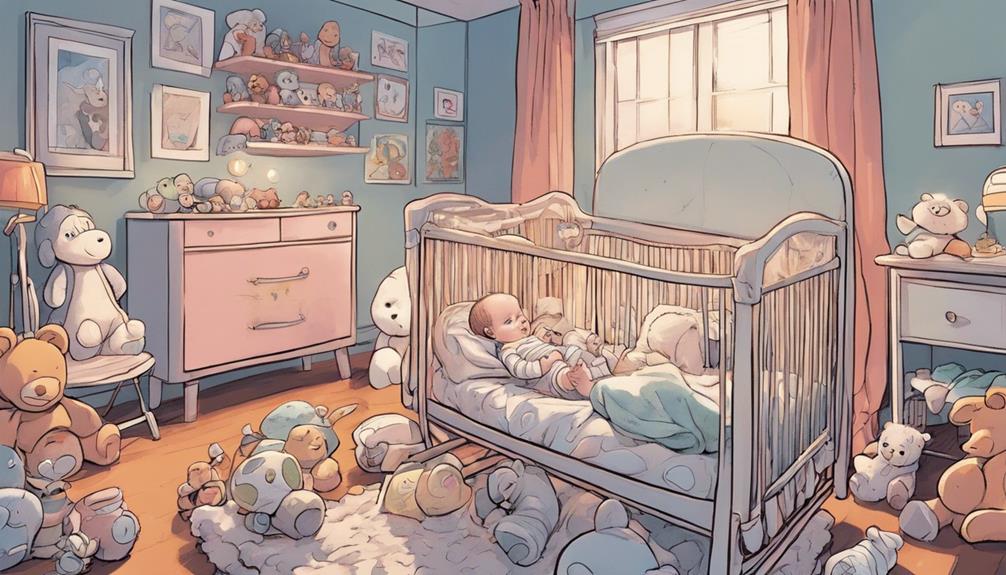
Teething can be tough on little ones, but several comforting techniques can help soothe sore gums effectively. One popular option is using refrigerated teething rings. The cold numbs discomfort without posing any harm, making them a go-to choice for many parents.
You can also try cold fruit in mesh pouches. This allows your baby to safely gnaw on the fruit while soothing their gums at the same time.
Additionally, soaking washcloths in breast milk or formula and chilling them can provide a comforting texture and taste that babies often enjoy during teething.
Another effective method is offering a clean, frozen washcloth. When your little one gnaws on it, the cold sensation can diminish gum soreness remarkably.
Remember to keep a close eye on your infant during these comfort measures. It's essential to prevent choking and guarantee the safe use of teething aids.
Teething Myths
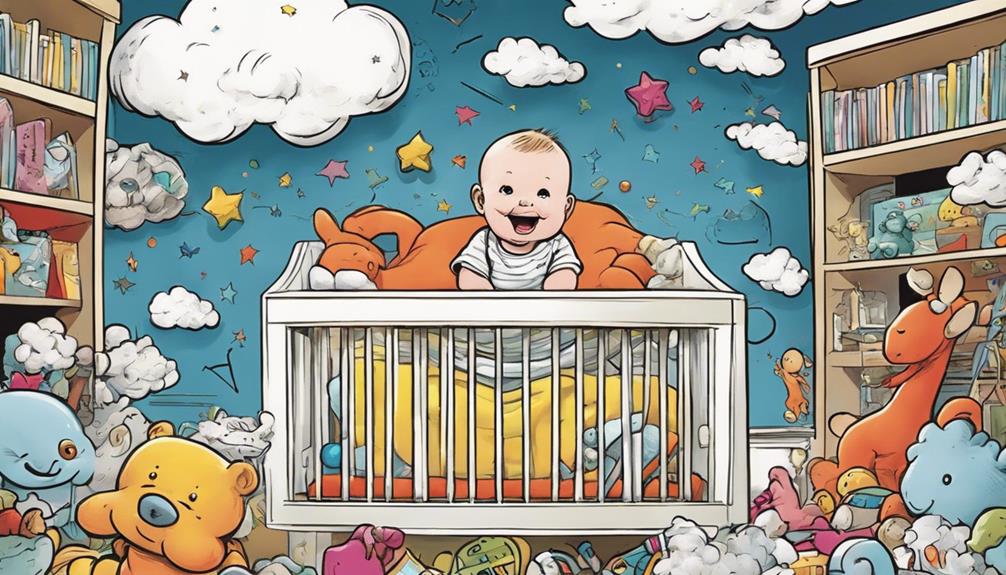
When it comes to teething, you might've heard a few common myths that can cause confusion.
Many parents worry about symptoms like diarrhea or high fevers, but these aren't linked to teething at all.
Let's clear up these misconceptions and discuss what you really need to know about teething.
Common Teething Misconceptions
Many parents hold onto common teething myths that can lead to unnecessary worries about their baby's health. Understanding the facts can help you navigate this phase more confidently. Here are some misconceptions you might encounter:
- Teething causes diarrhea: Studies show no evidence linking teething to diarrhea; it usually indicates other health issues.
- Teething leads to high fevers: While mild temperature increases can occur, true fevers above 100.4°F signal an illness, not teething.
- All babies experience notable discomfort: Many infants show little to no signs of pain or irritability during teething.
It's crucial to recognize these common teething misconceptions to better support your child's dental health.
Instead of relying on teething gels or worrying about tooth decay from myths, focus on your baby's unique signs and consult a pediatrician for any unusual symptoms.
Teething and Fever Link
Parents often worry that their baby's teething might trigger high fevers, but research shows this is a misconception. The American Academy of Pediatrics states that teething typically results in only a mild temperature increase, not exceeding 100.4°F (38°C). Understanding the actual link between teething and fever can ease your concerns.
Here's a quick overview of common misconceptions about teething and fever:
| Teething Symptoms | Actual Effects | What to Look For |
|---|---|---|
| High Fever | Mild temperature increase | Signs of severe illness |
| Diarrhea | Not a symptom | Evaluate other causes |
| Swollen Gums | Normal teething symptom | Irritability, drooling |
| Fretfulness | Typical behavior | Monitor for serious symptoms |
Teething symptoms, like swollen gums and increased drooling, are normal parts of development. It's essential to distinguish these from more serious health issues. If your baby seems unusually unwell, consult a healthcare professional. By understanding these facts, you can alleviate unnecessary worry and focus on supporting your baby's teething journey.
Teething Symptoms Confusion
Teething myths often lead to confusion about what symptoms are normal and what might signal a more serious issue. When your baby starts teething, it's important to distinguish between common teething symptoms and signs of illness. Many parents mistakenly believe that teething causes severe symptoms like high fever or diarrhea, which typically indicate other health issues.
Here are some key points to reflect on:
- Normal teething symptoms include increased drooling, mild irritability, and swollen gums.
- Teething necklaces are often marketed as solutions, but their effectiveness and safety are questionable.
- Despite teething, most babies maintain their usual eating and sleeping habits, so don't worry too much about changes in your child's diet.
Understanding these differences can help you respond appropriately to your child's needs.
Oral Hygiene Practices
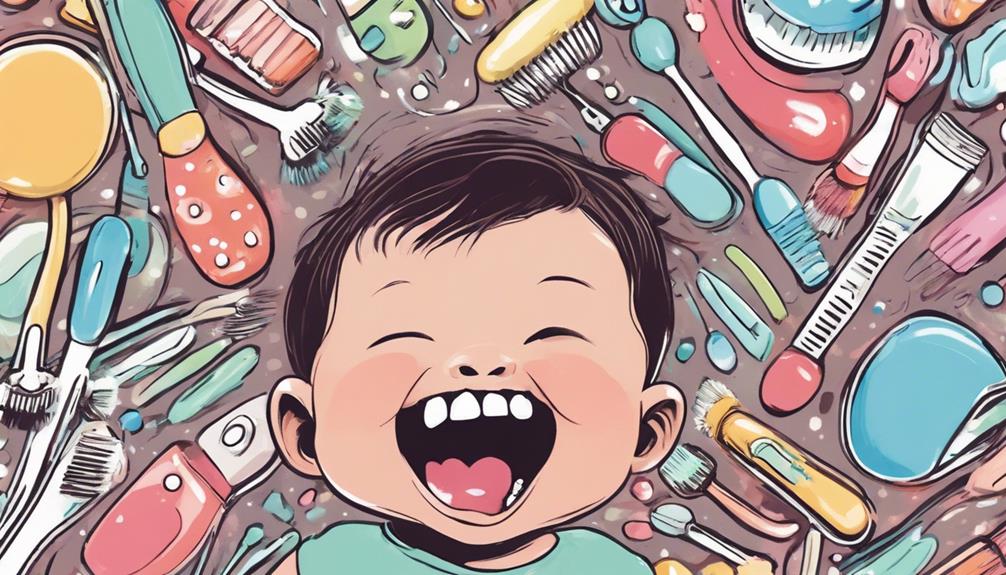
Cleaning your baby's gums with a soft, damp cloth before their teeth come in sets the foundation for excellent oral hygiene habits. This early practice helps remove bacteria and establishes a routine that prepares them for the arrival of their first tooth.
As soon as that first tooth appears, it's time to start brushing! Use a soft-bristled toothbrush and apply a smear of fluoride toothpaste to help protect their developing teeth.
Brush twice daily, ideally after meals, to prevent tooth decay and guarantee their dental health stays on track. For children over the age of 3, increase the amount of fluoride toothpaste to a pea-sized amount, but make sure they can spit it out properly. This is essential for effective oral hygiene as they grow older.
Don't forget to schedule your child's first dental visit by their first birthday or within six months of the first tooth erupting. This early visit can provide valuable insights into proper dental care and hygiene practices tailored for your little one.
Dietary Considerations

A balanced diet remains essential for your baby's health and development, even during the teething phase. You don't need to change your baby's diet; they can continue enjoying familiar solid foods. In fact, once teeth start to emerge, your baby might find it satisfying to bite down on food, which can help relieve some discomfort associated with teething.
It's important to maintain dietary considerations during this time. Make certain your baby receives a variety of nutrients to support their overall health.
Here are some tips for promoting healthy eating habits during teething:
- Offer a variety of solid foods: Introduce fruits, vegetables, and grains to keep meals interesting.
- Keep textures in mind: Soft, mushy foods can be easier to eat while their gums are sensitive.
- Encourage self-feeding: Let your baby explore food with their hands to foster independence.
Managing Teething Pain

Managing your baby's teething pain can be challenging, but there are effective strategies to help soothe their discomfort. One of the most immediate ways to provide relief is by gently massaging your baby's gums with a clean finger. This simple action can alleviate some of the pain associated with teething.
You can also try cold items, like refrigerated teething rings or frozen washcloths. The cool sensation can numb the gums and reduce inflammation, making it a great option for pain relief.
Keep an eye out for increased drooling, which is common during this stage, as it can sometimes lead to skin irritation.
While mild fever (under 102°F) may accompany teething, monitor your baby closely for any worsening symptoms. If you feel the need for medication, always consult your pediatrician first. They can guide you on safe options, especially since teething gels with benzocaine aren't recommended for infants under 2 years old.
First Dental Visit
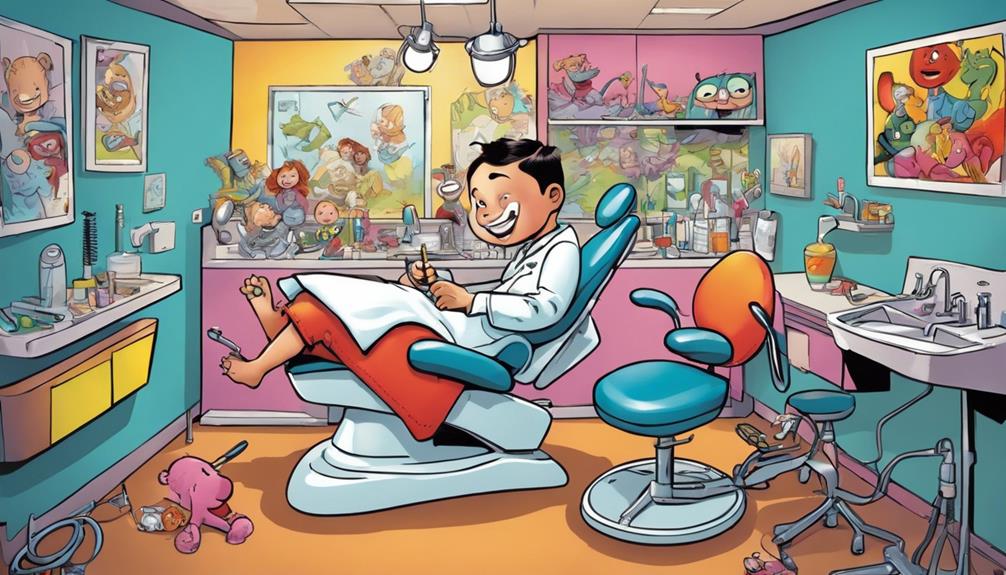
Scheduling your baby's first dental visit after their first tooth erupts, ideally by their first birthday, sets the foundation for a lifetime of good oral health.
The American Dental Association (ADA) recommends establishing a dental home early to monitor your child's oral hygiene and development.
During this visit, the dentist will:
- Assess the overall health of your child's teeth as they begin to appear.
- Provide guidance on proper oral hygiene practices for infants.
- Discuss normal dental development milestones and what to expect.
Your first dental visit isn't just about checking for cavities; it's a chance to build a positive relationship between your child and dental care providers.
A pediatric dentist can offer specialized advice tailored for infants, but if one isn't available, a general dentist can also provide appropriate care.
Remember, instilling good habits early can greatly impact your child's future oral health.
Frequently Asked Questions
Where Do Baby Teeth Come in First?
When you're wondering where baby teeth come in first, you'll find it's the lower central incisors. They usually appear between 6 to 10 months, followed by the upper central incisors a bit later.
In What Order Do Babies Teeth Come Through?
When it comes to the order of teeth coming through, you'll notice lower central incisors first, then upper central incisors, followed by upper lateral incisors, molars, canines, and finally, second molars.
When Do Teeth Come in a Chart?
When you look at a chart for baby teeth, you'll see they typically emerge in a specific order. Lower central incisors start around 6 to 10 months, followed by upper central incisors around 8 to 12 months.
What Causes Babies to Get Teeth Early?
Did you know that about 1 in 2,000 babies are born with teeth? Early tooth eruption can be influenced by genetics, nutrition, breastfeeding, and certain health conditions, all affecting when your baby's teeth come in.
At What Age Do Babies Typically Get Their First Teeth?
Babies typically get their first teeth around 6 months of age, but it can vary. Some babies start teething as early as 3 months, while others may not get their first tooth until they are 12 months old. This is the general period where babies teeth start to emerge.
Conclusion
As your little one sets off on this journey of teething, each emerging tooth symbolizes a new stage of growth and discovery.
Embrace the challenges and joys that come with this transformation, nurturing their comfort and well-being along the way.
With patience and love, you'll help them navigate through the discomfort, ensuring their smile shines bright.
Remember, just like the blooming of a flower, each tooth is a step toward their blossoming future.
